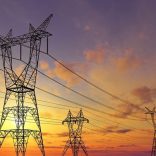US, China talks sketch out rare earths, tariff pause for Trump and Xi to consider
US: Millions flee as they brace for Hurricane Matthew – Watch

The fiercest Caribbean storm in nearly a decade slammed into the Bahamas early on Thursday, intensifying as it barrelled towards the southeast US coast where millions of residents heeded warnings to flee inland.
Roadways in Florida, Georgia and North and South Carolina were jammed and gas stations and food stores ran out of supplies as Hurricane Matthew approached, packing storm surges, heavy rain and sustained winds that accelerated overnight to around 125 miles (205 km) per hour.
Matthew, which killed at least 26 people and damaged swathes of homes in southern Haiti, was predicted to strengthen from a Category 3 to 4 storm en route to eastern Florida.
Landfall was expected there on Thursday night, the U.S. National Hurricane Center said, extending its hurricane warning area further north into Georgia in its 6 am EST (1000GMT) advisory.
“Everyone in our state must prepare now for a direct hit,” Florida Governor Scott told a news conference in Tallahassee on Wednesday. “If Matthew directly impacts Florida, the destruction could be catastrophic and you need to be prepared.”
The four states in the path of the hurricane, tracked 255 miles (410 km) southeast of West Palm Beach, declared states of emergency enabling their governors to mobilize the National Guard.
Shelters in Florida, Georgia and South Carolina opened their doors after authorities, along with President Barack Obama, urged locals to evacuate their homes.
Federal emergency response teams were coordinating with officials in all four states and stockpiling supplies, Obama said.
Scott requested that Obama declare a pre-landfall emergency for Florida, which would bring resources including as food, water and waterproof coverings and double the active National Guard force to 3,000.
Schools and airports across the region were closed on Thursday and some hospitals evacuated patients, according to local media.
‘All boarded up’
In all, more than 12 million U.S. residents were under a hurricane watches and warnings, according to the Weather Channel.
In Florida, fuel stations posted “out of gas” signs after cars waited in long lines to fill up.
“Every gas station I went to is empty,” said motorist Charles Bivona in a Tweet late Wednesday. “Here comes Hurricane Matthew. Um, yikes.”
Others, meanwhile, prepared to wait out the storm.
People stocked up on water, milk and canned goods, emptying grocery store shelves, footage from local media showed.
Residents and business owners boarded up windows with plywood and hurricane shutters and placed sandbags down to protect property against flooding.
“All boarded up and ready to bunker down. God be with us,” West Palm Beach Florida resident Brad Gray said in a Tweet.
The National Hurricane Center said it was still too soon to predict where in the United States Matthew was likely to do the most damage.
On Tuesday and Wednesday the storm whipped Cuba and Haiti with 140 mile-per-hour (230 kph) winds and torrential rains, pummeling towns and destroying livestock, crops and homes.
The devastation in Haiti prompted authorities to postpone a presidential election.
Al Jazeera senior metereologist, Steff Gaulter, explains Matthew:
“Hurricane Matthew is showing signs of rejuvenating as it batters the islands of the Bahamas.
As it made landfall, it was classed as a Category three hurricane on the five-point Saffir-Simpson scale used to measure the strength of hurricanes in the waters around the Americas.
The storm had lost intensity as it churned across Cuba and Haiti, and the high ground of the islands caused it to lose intensity.
However, the conditions are now favourable for the hurricane to strengthen.
The storm is no-longer being affected by high ground and the winds are not too strong high up in the atmosphere. This ensures the storm can rejuvenate itself without any obstructions.
Also the waters around the Bahamas are warmer than usual for this time of year. Warm waters are the energy source of these tropical systems, and the warmer the water is, the more energy is available to feed the storm.
The thunderstorms in the eye of the storm are already becoming more intense and more organised, and the pressure in the centre of the storm is dropping.
These are indications that the storm is preparing to strengthen. Hurricane Matthew is expected to be a powerful category four hurricane by the time it reaches Florida’s coastline, with sustained winds of over 209 kilometres per hour.
There is even a small chance it could become a category five storm before it approaches the coast.
The area most at risk from the storm is from Palm Beach northwards to Jacksonville, although it is still very unclear whether the eye of the storm will make landfall.
Whether the eye actually hits the coast or not, it seems highly likely that the storm will get close enough to cause a major storm surge, torrential rain, severe wind damage and significant coastal erosion.
It is expected to churn northwards along, or very close to, the east coast of Florida, meaning millions of people would be affected by the powerful storm.
Hurricane Matthew is expected to start to effect Florida from this evening local time, and continue to batter the coast for about 24 hours.
Some locations in northeast Florida have never experienced a hurricane of this magnitude and the threat of landfall has prompted major evacuations.
The Governor, Rick Scott, said Florida could be facing its “biggest evacuation ever” as the storm bears down on the state.”












Leave a Reply
Be the First to Comment!
You must be logged in to post a comment.
You must be logged in to post a comment.